Bio-Inspired Sustainability Assessment for Building Product Development—Concept and Case Study
Abstract
:1. Introduction
2. Development of the Assessment System
- Requirement specification
- Initial situation
- Sustainability
- Bio-inspiration
- Synthesis creation
- Application
- Validation
- Adaption
2.1. Requirements to a Bio-Inspired Sustainability Assessment
2.2. Properties of Sustainability Assessment Methods
2.3. Biological Idea Generators for Sustainability Assessment
2.4. Bio-Inspired Sustainability Assessment
- Environmental burden: the unintended impacts of the assessed system to the environment based on an environmental life cycle assessment
- Environmental function: the dedicated design functions aiming at positively impacting the environment, calculated based on environmental life cycle assessment
- Economic burden: the life cycle related costs calculated based on the life cycle assessment model completed through process immanent costs and nonmaterial costs
- Economic function: the economic function from the point of view of the shareholders, calculated as economic profitability
- Social burden: the unintended effects of the assessed system on human society, calculated as impact on human capabilities and health, calculated based on environmental life cycle assessment
- Social function: the primary design function restricted to the intended building physical function of the assessed system
2.4.1. Environmental Burden
2.4.2. Environmental Function
2.4.3. Economic Burden
2.4.4. Economic Function
2.4.5. Social Burden
2.4.6. Social Function
3. Application
3.1. Bio-Flexi—A Biobased and Biodegradable Composite
3.2. Technical Characterization
3.3. Bio-Inspired Sustainability of Bio-Flexi
4. Discussion
5. Conclusions
- Are the bio-inspired requirements useful as criteria for meta-assessment and does the BiSA meet them?
- How could BiSA support the degree of target attainment in terms of developing sustainable solutions in the building sector?
- Is it possible to directly integrate further success principles of evolution (multifunctionality and change of function) in the assessment structure?
- Is it useful (or eligible) to determine the detailed structure or should the model itself be adaptive?
- Is it possible to fully address the meta-assessment classification requirements to sustainability assessments through further model development?
- Is it possible to gain a deeper understanding of the biological model systems in the framework of a further development of the BiSA?
Acknowledgments
Author Contributions
Conflicts of Interest
References
- Dickens, P. Reconstructing Nature: Alienation, Emancipation and the Division of Labour; Routledge: London, UK; New York, NY, USA, 1996. [Google Scholar]
- Von Storch, H.; Stehr, N. Climate change in perspective. Nature 2000, 405, 615. [Google Scholar] [CrossRef] [PubMed]
- Heidegger, M. The Question Concerning Technology; Garland Publishing: New York, NY, USA, 1977. [Google Scholar]
- Cruzen, P.J. Geology of mankind: The Anthropocene. Nature 2002, 415, 23. [Google Scholar] [CrossRef] [PubMed]
- Rockström, J.; Steffen, W.; Noone, K.; Persson, Å.; Chapin, F.S.I.; Lambin, E.; Lenton, T.M.; Scheffer, M.; Folke, C.; Schellnhuber, H.J.; et al. Planetary Boundaries: Exploring the Safe Operating Space for Humanity. Ecol. Soc. 2009, 14, 32. [Google Scholar] [CrossRef]
- Von Carlowitz, H.C. Sylvicultura Oeconomica Oder Haußwirthliche Nachricht und Naturgemäßige Anweisung zur Wilden Baum-Zucht; Johan Friedrich Braun: Leipzig, Germany, 1713. [Google Scholar]
- Hawken, P.; Lovins, A.B.; Lovins, L.H. Natural Capitalism: Creating the Next Industrial Revolution, 1st ed.; Little, Brown and Co.: Boston, MA, USA, 1999. [Google Scholar]
- Von Gleich, A. Das bionische Versprechen: Ist die Bionik so gut wie ihr Ruf? Ökologisches Wirtsch. 2007, 22, 21–23. [Google Scholar]
- Reap, J.; Baumeister, D.; Bras, B. Holism, Biomimicry and Sustainable Engineering. In Energy Conversion and Resources; ASME: New York, NY, USA, 2005; pp. 423–431. [Google Scholar]
- Horn, R.; Gantner, J.; Widmer, L.; Sedlbauer, K.P.; Speck, O. Bio-inspired Sustainability Assessment: A Conceptual Framework. In Biomimetic Research for Architecture and Building Construction: Biological Design and Integrative Structures; Knippers, J., Nickel, K.G., Speck, T., Eds.; Springer: Cham, Switzerland, 2016; Volume 8, pp. 361–377. [Google Scholar]
- Speck, O.; Speck, D.; Horn, R.; Gantner, J.; Sedlbauer, K.P. Biomimetic bio-inspired biomorph sustainable? An attempt to classify and clarify biology-derived technical developments. Bioinspir. Biomim. 2017, 12, 11004. [Google Scholar]
- Margulis, L.; Sagan, D.; Sagan, C. Life, Biology; Autopoietic Definition of Life; Encyclopædia Britannica, Inc.: Chicago, IL, USA, 2017; Available online: https://www.britannica.com/topic/life#ref1014068 (accessed on 3 November 2017).
- Varela, F.G.; Maturana, H.R.; Uribe, R. Autopoiesis: The organization of living systems, its characterization and a model. Biosystems 1974, 5, 187–196. [Google Scholar] [CrossRef]
- Popper, K.R. Logik der Forschung, 11th ed.; Mohr Siebeck: Tübingen, Germany, 2005. [Google Scholar]
- Parker, C. An approach to requirements analysis for decision support systems. Int. J. Hum. Comput. Stud. 2001, 55, 423–433. [Google Scholar] [CrossRef]
- Steele, K.; Stefánsson, H.O. Decision Theory. In The Stanford Encyclopedia of Philosophy, 2016th ed.; Zalta, E.N., Ed.; Metaphysics Research Lab., Stanford University: Stanford, CA, USA, 2016. [Google Scholar]
- Sprague, R.H. A Framework for the Development of Decision Support Systems. MIS Q. 1980, 4, 1–26. [Google Scholar] [CrossRef]
- Sala, S.; Farioli, F.; Zamagni, A. Life cycle sustainability assessment in the context of sustainability science progress (part 2). Int. J. Life Cycle Assess. 2013, 18, 1686–1697. [Google Scholar] [CrossRef]
- Sala, S.; Ciuffo, B.; Nijkamp, P. A systemic framework for sustainability assessment. Ecol. Econ. 2015, 119, 314–325. [Google Scholar] [CrossRef]
- Finkbeiner, M.; Schau, E.M.; Lehmann, A.; Traverso, M. Towards Life Cycle Sustainability Assessment. Sustainability 2010, 2, 3309–3322. [Google Scholar] [CrossRef]
- UNEP/SETAC Life Cycle Initiative. Towards a Life Cycle Sustainability Assessment: Making Informed Choices on Products; United Nations Environment Programme: Nairobi, Kenya, 2011. [Google Scholar]
- Kloepffer, W. Life cycle sustainability assessment of products. Int. J. Life Cycle Assess. 2008, 13, 89–95. [Google Scholar] [CrossRef]
- Sala, S.; Farioli, F.; Zamagni, A. Progress in sustainability science: Lessons learnt from current methodologies for sustainability assessment: Part 1. Int. J. Life Cycle Assess. 2013, 18, 1653–1672. [Google Scholar] [CrossRef]
- Folke, C.; Carpenter, S.; Elmqvist, T.; Gunderson, L.; Holling, C.S.; Walker, B. Resilience and Sustainable Development: Building Adaptive Capacity in a World of Transformations. AMBIO J. Hum. Environ. 2002, 31, 437–440. [Google Scholar] [CrossRef]
- Moore, F.C. Toppling the Tripod: Sustainable Development, Constructive Ambiguity and the Environmental Challenge. Cons. J. Sustain. Dev. 2011, 1, 141–150. [Google Scholar]
- World Commission on Environment and Development. Report of the World Commission on Environment and Development: Our Common Future; Oxford University Press: Oxford, UK, 1987; Available online: http://www.un-documents.net/our-common-future.pdf (accessed on 3 January 2018).
- Zamagni, A.; Pesonen, H.-L.; Swarr, T. From LCA to Life Cycle Sustainability Assessment: Concept, practice and future directions. Int. J. Life Cycle Assess. 2013, 18, 1637–1641. [Google Scholar] [CrossRef]
- Parent, J.; Cucuzzella, C.; Revéret, J.-P. Revisiting the role of LCA and SLCA in the transition towards sustainable production and consumption. Int. J. Life Cycle Assess. 2013, 18, 1642–1652. [Google Scholar] [CrossRef]
- Braungart, M.; McDonough, W. Cradle to Cradle: Einfach Intelligent Produzieren; Piper: München, Germany; Zürich, Switzerland, 2014. [Google Scholar]
- Bjørn, A.; Hauschild, M.Z. Cradle to Cradle and LCA—Is there a Conflict? In Glocalized Solutions for Sustainability in Manufacturing, Proceedings of the 18th CIRP International Conference on Life Cycle Engineering, Technische Universität Braunschweig, Braunschweig, Germany, 2–4 May 2011; Hesselbach, J., Herrmann, C., Eds.; Springer: Berlin/Heidelberg, Germany, 2011; pp. 599–604. [Google Scholar]
- Onat, N.C.; Kucukvar, M.; Tatari, O. Integrating triple bottom line input–output analysis into life cycle sustainability assessment framework: The case for US buildings. Int. J. Life Cycle Assess. 2014, 19, 1488–1505. [Google Scholar] [CrossRef]
- Hacking, T.; Guthrie, P. A framework for clarifying the meaning of Triple Bottom-Line, Integrated, and Sustainability Assessment. Environ. Impact Assess. Rev. 2008, 28, 73–89. [Google Scholar] [CrossRef]
- Onat, N.; Kucukvar, M.; Halog, A.; Cloutier, S. Systems Thinking for Life Cycle Sustainability Assessment: A Review of Recent Developments, Applications, and Future Perspectives. Sustainability 2017, 9, 706. [Google Scholar] [CrossRef]
- Petti, L.; Serreli, M.; Di Cesare, S. Systematic literature review in social life cycle assessment. Int. J. Life Cycle Assess. 2016, 18, 1549. [Google Scholar] [CrossRef]
- Guinée, J. Life Cycle Sustainability Assessment: What Is It and What Are Its Challenges? In Taking Stock of Industrial Ecology; Clift, R., Druckman, A., Eds.; Springer International Publishing: Cham, Switzerland, 2016; pp. 45–68. [Google Scholar]
- Von Gleich, A.; Pade, C.; Petschow, U.; Pissarskoi, E. Bionik: Aktuelle Trends und Zukünftige Potenziale; Institut für ökologische Wirtschaftsforschung: Berlin, Germany, 2007. [Google Scholar]
- Frey, E.; Masselter, T.; Speck, T. Was ist bionisch? Eine Anal. Ideenflusses Biol. Tech. Naturwissensch. Rundsch. 2011, 64, 117–126. [Google Scholar]
- Coineau, Y.; Kresling, B. Erfindungen der Natur; Tessloff: Nürnberg, Germany, 1989. [Google Scholar]
- Barthlott, W.; Neinhuis, C. Purity of the sacred lotus, or escape from contamination in biological surfaces. Planta 1997, 202, 1–8. [Google Scholar] [CrossRef]
- Lienhard, J.; Schleicher, S.; Poppinga, S.; Masselter, T.; Milwich, M.; Speck, T.; Knippers, J. Flectofin: A hingeless flapping mechanism inspired by nature. Bioinspir. Biomim. 2011, 6, 45001. [Google Scholar] [CrossRef] [PubMed]
- Walsh, D.M. Fitness and Function. Br. J. Philos. Sci. 1996, 47, 553–574. [Google Scholar] [CrossRef]
- Achinstein, P. Function Statements. Philos. Sci. 1977, 44, 341–367. [Google Scholar] [CrossRef]
- Verein Deutscher Ingenieure VDI 6223/1. Bionik: Bionische Materialien, Strukturen und Bauteile; Biomimetics: Biomimetic Materials, Structures and Components VDI 6223 (Berlin: Beuth); Beuth: Berlin, Germany, 2013. [Google Scholar]
- Lexikon der Biologie. “Ressourcen”; Spektrum Akademischer Verlag: Heidelberg, Germany, 1999; Available online: http://www.spektrum.de/lexikon/biologie/ressourcen/56391 (accessed on 29 November 2017).
- Antony, F.; Grießhammer, R.; Speck, T.; Speck, O. Natur–(k)ein Vorbild für nachhaltige Entwicklung. In Bionik: Patente aus der Natur; Kesel, A., Zehren, D., Eds.; Meiners-Druck: Bremen, Germany, 2013; pp. 164–170. [Google Scholar]
- Speck, O. Das bionische Versprechen: Ein Beitrag zur Bildung für nachhaltige Entwicklung. In Bionik: Patente aus der Natur; Kesel, A., Zehren, D., Eds.; Meiners-Druck: Bremen, Germany, 2015; pp. 135–146. [Google Scholar]
- Walsh, D.M. Teleology. In The Oxford handbook of Philosophy of Biology, 1st ed.; Ruse, M., Ed.; Oxford University Press: Oxford, UK, 2010; pp. 113–137. [Google Scholar]
- Huiskes, R. If bone is the answer, then what is the question? J. Anat. 2000, 197, 145–156. [Google Scholar] [CrossRef] [PubMed]
- Sureau, S.; Mazijn, B.; Garrido, S.R.; Achten, W.M.J. Social life-cycle assessment frameworks: A review of criteria and indicators proposed to assess social and socioeconomic impacts. Int. J. Life Cycle Assess. 2017, 30, 181. [Google Scholar] [CrossRef]
- Benoît, C.; Mazijn, B. Guidelines for Social Life Cycle Assessment of Products; United Nations Environment Programme: Nairobi, Kenya, 2009. [Google Scholar]
- Jørgensen, A. Social LCA—A way ahead? Int. J. Life Cycle Assess. 2013, 18, 296–299. [Google Scholar] [CrossRef] [Green Version]
- Moosbrugger, V. Das große Sterben vor 65 Millionen Jahren. In Katastrophen in der Erdgeschichte—Wendezeiten des Lebens; Hansch, W., Ed.; Städtische Museen: Heilbronn, Germany, 2003; pp. 144–153. [Google Scholar]
- International Organization for Standardization. Umweltmanagement—Ökobilanz—Grundsätze und Rahmenbedingungen (ISO 14040:2006); Beuth: Berlin, Germany, 2009. [Google Scholar]
- International Organization for Standardization. Umweltmanagement—Ökobilanz—Anforderungen und Anleitungen (ISO 14044:2006): Environmental Management—Life Cycle Assessment—Requirements and Guidelines, 1st ed.; Beuth: Berlin, Germany, 2009. [Google Scholar]
- International Reference Life Cycle Data System (ILCD). ILCD Handbook—General Guide on LCA—Provisons and Action Steps//General Guide for Life Cycle Assessment: Provisions and Action Steps; Publications Office: Luxembourg, 2010. [Google Scholar]
- Thinkstep, A.G. GaBi TS: Sofware-System and Databases for Life Cycle Engineering; Thinkstep AG: Leinfelden-Echterdingen, Germany, 2017. [Google Scholar]
- Steffen, W.; Richardson, K.; Rockstrom, J.; Cornell, S.E.; Fetzer, I.; Bennett, E.M.; Biggs, R.; Carpenter, S.R.; de Vries, W.; Wit, C.A.D.; et al. Planetary boundaries: Guiding human development on a changing planet. Science 2015, 347, 1259855. [Google Scholar] [CrossRef] [PubMed]
- Ryberg, M.W.; Owsianiak, M.; Richardson, K.; Hauschild, M.Z. Challenges in implementing a Planetary Boundaries based Life-Cycle Impact Assessment methodology. J. Clean. Prod. 2016, 139, 450–459. [Google Scholar] [CrossRef]
- Sala, S.; Benini, L.; Crenna, E.; Secchi, M. Global Environmental Impacts and Planetary Boundaries in LCA: Data Sources and Methodological Choices for the Calculation of Global and Consumption-Based Normalisation Factors; European Commission: Brussels, Belgium, 2016. [Google Scholar]
- Sandin, G.; Peters, G.M.; Svanström, M. Using the planetary boundaries framework for setting impact-reduction targets in LCA contexts. Int. J. Life Cycle Assess. 2015, 20, 1684–1700. [Google Scholar] [CrossRef]
- Bjørn, A.; Hauschild, M. Integrating Planetary Boundaries into the Life Cycle Assessment Framework for Assessing Absolute Environmental Sustainability of Products and Systems. In Proceedings of the Third International Resilience Science and Policy Conference, Montpellier, France, 5–9 May 2014. [Google Scholar]
- Rockström, J.; Steffen, W.; Noone, K.; Persson, A.; Chapin, F.S.; Lambin, E.F.; Lenton, T.M.; Scheffer, M.; Folke, C.; Schellnhuber, H.J.; et al. A safe operating space for humanity. Nature 2009, 461, 472–475. [Google Scholar] [CrossRef] [PubMed]
- Pizzol, M.; Laurent, A.; Sala, S.; Weidema, B.; Verones, F.; Koffler, C. Normalisation and weighting in life cycle assessment: Quo vadis? Int. J. Life Cycle Assess. 2017, 22, 853–866. [Google Scholar] [CrossRef]
- Vidal Legaz, B.; Maia De Souza, D.; Teixeira, R.; Antón, A.; Putman, B.; Sala, S. Soil quality, properties, and functions in life cycle assessment: An evaluation of models. J. Clean. Prod. 2017, 140, 502–515. [Google Scholar] [CrossRef]
- Schneider, L.; Berger, M.; Finkbeiner, M. Abiotic resource depletion in LCA—Background and update of the anthropogenic stock extended abiotic depletion potential (AADP) model. Int. J. Life Cycle Assess. 2015, 20, 709–721. [Google Scholar] [CrossRef]
- Klinglmair, M.; Sala, S.; Brandão, M. Assessing resource depletion in LCA: A review of methods and methodological issues. Int. J. Life Cycle Assess. 2014, 19, 580–592. [Google Scholar] [CrossRef]
- Bos, U.; Horn, R.; Beck, T.; Lindner, J.P.; Fischer, M. LANCA—Characterization Factors for Life Cycle Impact Assessment: Version 2.0; Fraunhofer Verlag: Stuttgart, Germany, 2016. [Google Scholar]
- Swarr, T.E.; Hunkeler, D.; Klöpffer, W.; Pesonen, H.-L.; Ciroth, A.; Brent, A.C.; Pagan, R. Environmental life-cycle costing: a code of practice. Int. J. Life Cycle Assess. 2011, 16, 389–391. [Google Scholar] [CrossRef]
- Eurostat. Statistics on Industrial Production and International Trade (Prom), Annual Detailed Data by Prodcom List (According to NACE); Eurostat: Luxembourg, 2016; Available online: http://epp.eurostat.ec.europa.eu/newxtweb/ (accessed on 24 October 2017).
- Callejas, D.G. Biology and Economics: Metaphors that Economists usually take from Biology. Ecos Econ. 2007, 11, 153–164. [Google Scholar]
- Jørgensen, A.; Le Bocq, A.; Nazarkina, L.; Hauschild, M. Methodologies for social life cycle assessment. Int. J. Life Cycle Assess. 2008, 13, 96–103. [Google Scholar] [CrossRef]
- Sala, S.; Vasta, A.; Mancini, L.; Dewulf, J.; Rosenbaum, E. Social Life Cycle Assessment: State of the Art and Challenges for Product Policy Support; Publications Office: Luxembourg, 2015. [Google Scholar]
- Chhipi-Shrestha, G.K.; Hewage, K.; Sadiq, R. ‘Socializing’ sustainability: A critical review on current development status of social life cycle impact assessment method. Clean Technol. Environ Policy 2015, 17, 579–596. [Google Scholar] [CrossRef]
- Iofrida, N.; de Luca, A.I.; Strano, A.; Gulisano, G. Can social research paradigms justify the diversity of approaches to social life cycle assessment? Int. J. Life Cycle Assess. 2016, 20, 498. [Google Scholar] [CrossRef]
- Okasha, S. Biological Altruism. In The Stanford Encyclopedia of Philosophy, 2013rd ed.; Zalta, E.N., Ed.; Metaphysics Research Lab., Stanford University: Stanford, CA, USA, 2013. [Google Scholar]
- Auletta, G.; Leclerc, M.; Martínez, R.A. (Eds.) Biological Evolution: Facts and Theories: A Critical Appraisal 150 Years after “The Origin of Species”. In Proceedings of the 3rd ICSD International Conference, Rome, Italy, 3–7 March 2009; Gregorian & Biblical Press: Roma, Italy, 2011. [Google Scholar]
- Alexander, R. Biology and the moral paradoxes. J. Soc. Biol. Syst. 1982, 5, 389–395. [Google Scholar] [CrossRef]
- FitzPatrick, W. Morality and Evolutionary Biology. In The Stanford Encyclopedia of Philosophy; Stanford University: Stanford, CA, USA, 2016. [Google Scholar]
- Sen, A. Development as Freedom, 1st ed.; Knopf: New York, NY, USA, 2001. [Google Scholar]
- Fantke, P.; Bijster, M.; Hauschild, M.Z.; Huijbregts, M.; Jolliet, O.; Kounina, A.; Magaud, V.; Margni, M.; McKone, T.E.; Rosenbaum, R.K.; et al. USEtox® 2.0 Documentation (Version 1.00); USEtox® Team: Bordeaux, France, 2017. [Google Scholar]
- Alkire, S. Dimensions of Human Development. World Dev. 2002, 30, 181–205. [Google Scholar] [CrossRef]
- Aulisio, D. All SHDB Tables, Indicators, Characterizations-Update; Social Hotspots Database; York, ME, USA, 2013. Available online: http://socialhotspot.org/wp-content/uploads/2013/03/All-SHDB-Tables-Indicators-Characterizations-UPDATE.pdf (accessed on 8 January 2018).
- Barthel, L.-P. Methode zur Abschätzung Sozialer Aspekte in Lebenszyklusuntersuchungen auf Basis Statistischer Daten; Fraunhofer Verlag: Stuttgart, Germany, 2015. [Google Scholar]
- Albrecht, S.; Endres, H.-J.; Knüpffer, E.; Spierling, S. Biokunststoffe—Quo vadis? UmweltWirtschaftsForum 2016, 24, 55–62. [Google Scholar] [CrossRef]
- Gantner, J.; Beck, T.; Horn, R. CommONEnergy Deliverable 5.7: Social Impact Assessment of Shopping Mall Retrofitting; European Commission: Brussels, Belgium, 2017. [Google Scholar]
- Reitinger, C.; Dumke, M.; Barosevcic, M.; Hillerbrand, R. A conceptual framework for impact assessment within SLCA. Int. J. Life Cycle Assess. 2011, 16, 380–388. [Google Scholar] [CrossRef]
- Buller, D.J. (Ed.) Function, Selection and Design; State University of New York Press: Albany, NY, USA, 1999. [Google Scholar]
- Verein Deutscher Ingenieure VDI 6220/1. Bionik—Konzeption und Strategie—Abgrenzung Zwischen Bionischen und Konventionellen Verfahren/Produkten; Biomimetics—Conception and Strategy—Differences between Biomimetic and Conventional Methods/Products; ICS 07.080; Beuth: Berlin, Germany, 2012. [Google Scholar]
- Moro, J.L. Baukonstruktion: Vom Prinzip zum Detail; Springer: Berlin, Germany, 2009. [Google Scholar]
- Dahy, H.; Knippers, J. Flexible High-Density Fiberboard and Method for Manufacturing the Same. EP3166765A1; Filed 8. July 2014, published 13 January 2016. Based on Same Patent, Also Applied as WO2016005026A1; CN106604806A; US20170144327, EP2965882 A1, Available online: https://patentscope.wipo.int/search/en/detail.jsf?docId=WO2016005026 (accessed on 8 January 2018).
- Dahy, H. Biocomposite materials based on annual natural fibres and biopolymers—Design, fabrication and customized applications in architecture. J. Constr. Build. Mater. 2017, 147, 212–220. [Google Scholar] [CrossRef]
- Dahy, H. Agro-Fibres Biocomposites Applications and Design Potentials in Contemporary Architecture: Case Study: Rice Straw Biocomposites; Forschungsbericht Nr. 38; Universität Stuttgart: Stuttgart, Germany, 2015; Available online: http://dx.doi.org/10.18419/opus-113 (accessed on 8 January 2018).
- Deutsches Institut für Normung e. V. DIN EN 15978. Nachhaltigkeit von Bauwerken—Bewertung der Umweltbezogenen Qualität von Gebäuden—Berechnungsmethode; Deutsche Fassung EN 15978-2011; Beuth: Berlin, Germany, 2012. [Google Scholar]
- Kuhn, T.S. The Structure of Scientific Revolutions, 2nd ed.; University of Chicago Press: Chicago, IL, USA, 1970. [Google Scholar]
- Ziegler, R.; Ott, K. The quality of sustainability science: A philosophical perspective. Sustain. Sci. Pract. Policy 2017, 7, 31–44. [Google Scholar]
- Dietz, S.; Neumayer, E. Weak and strong sustainability in the SEEA: Concepts and measurement. Ecol. Econ. 2007, 61, 617–626. [Google Scholar] [CrossRef]
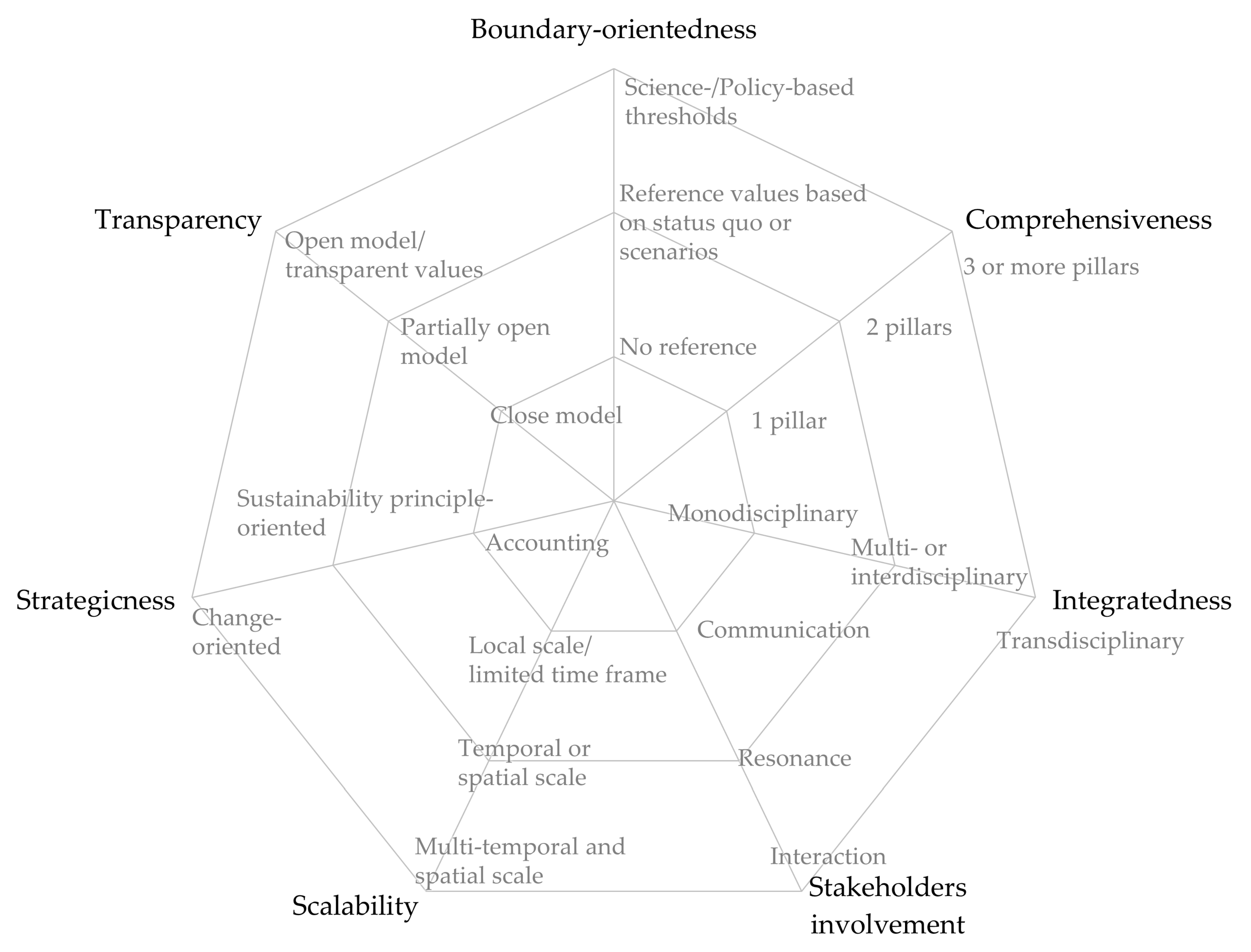
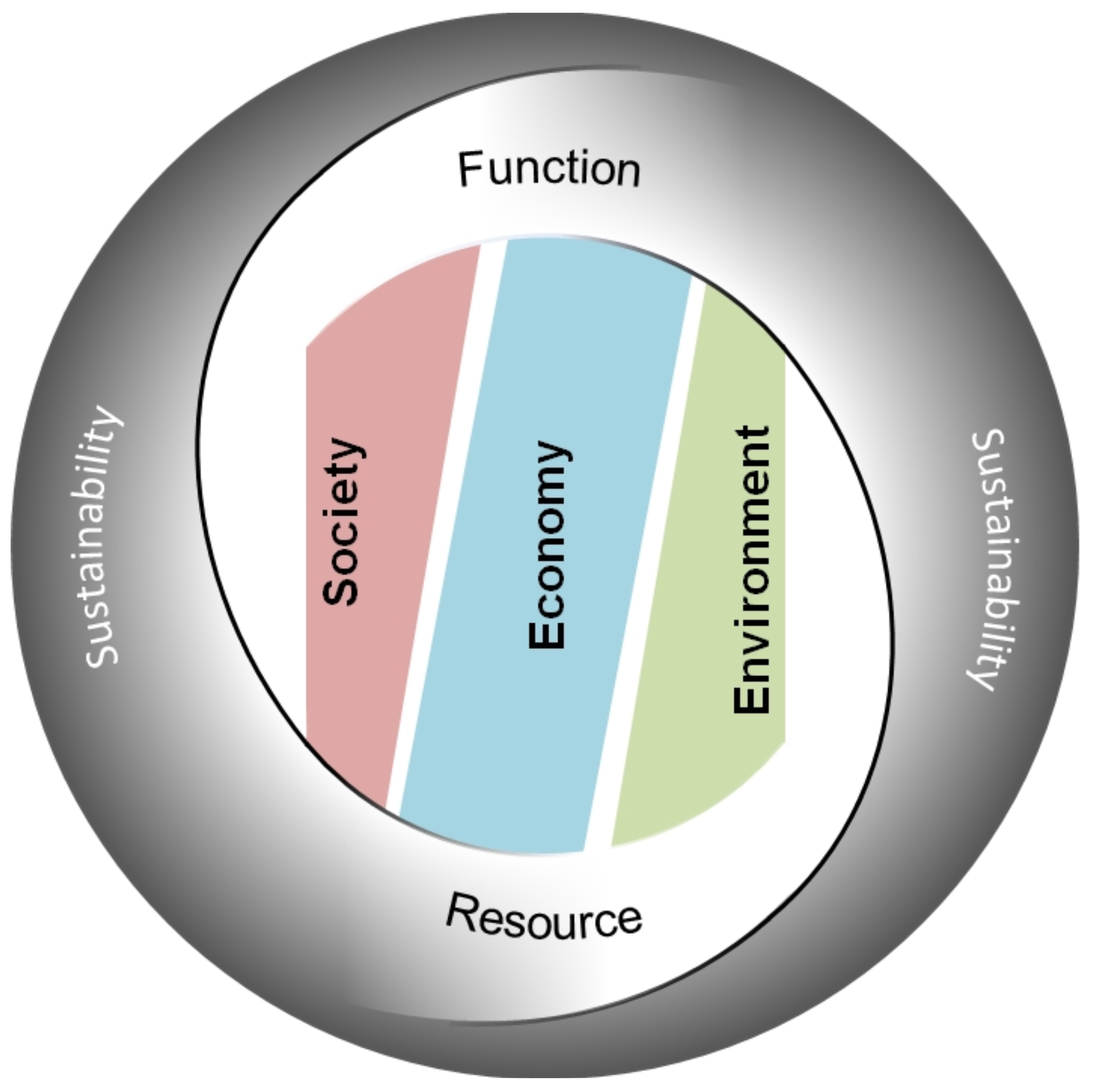
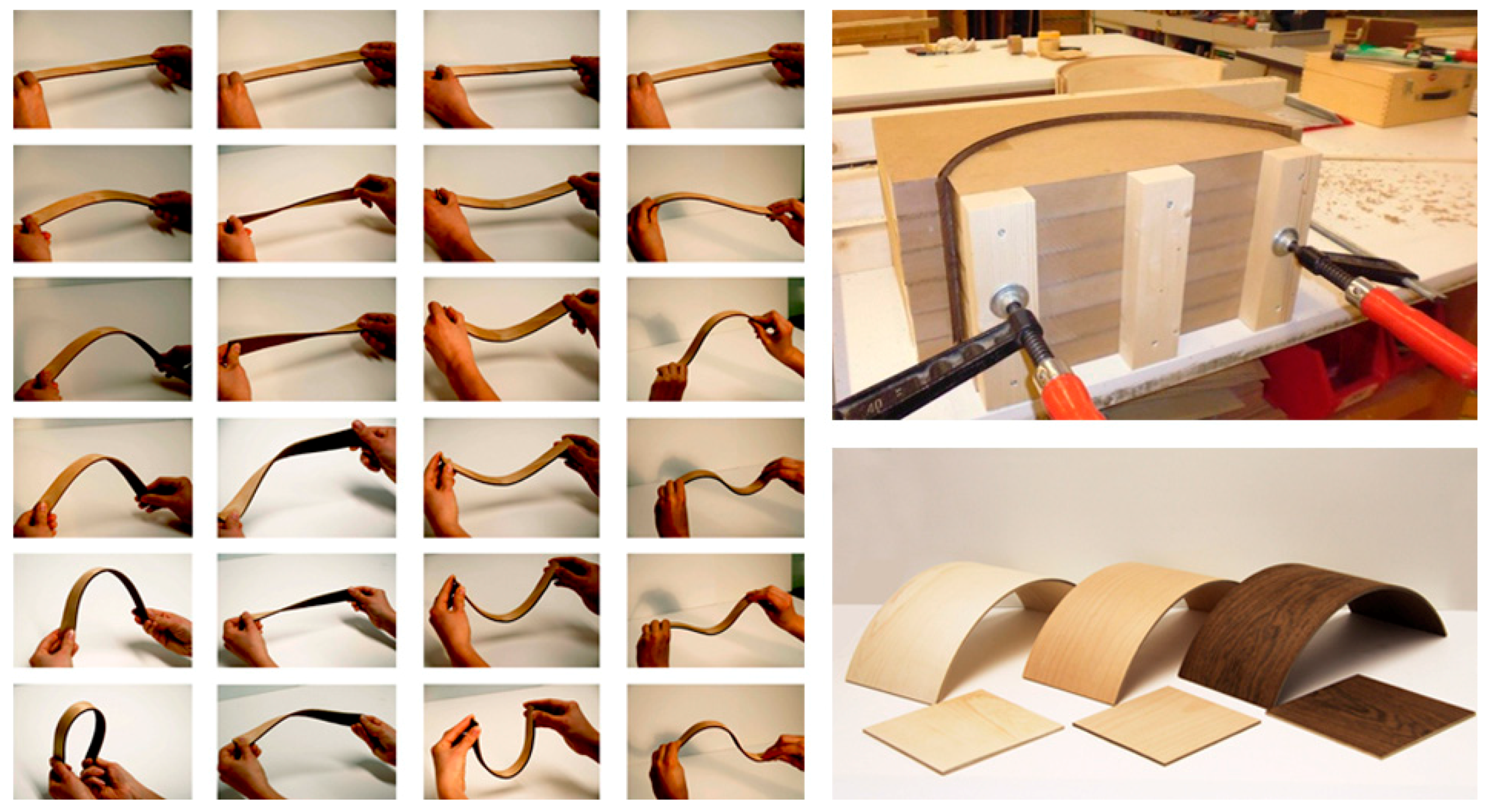
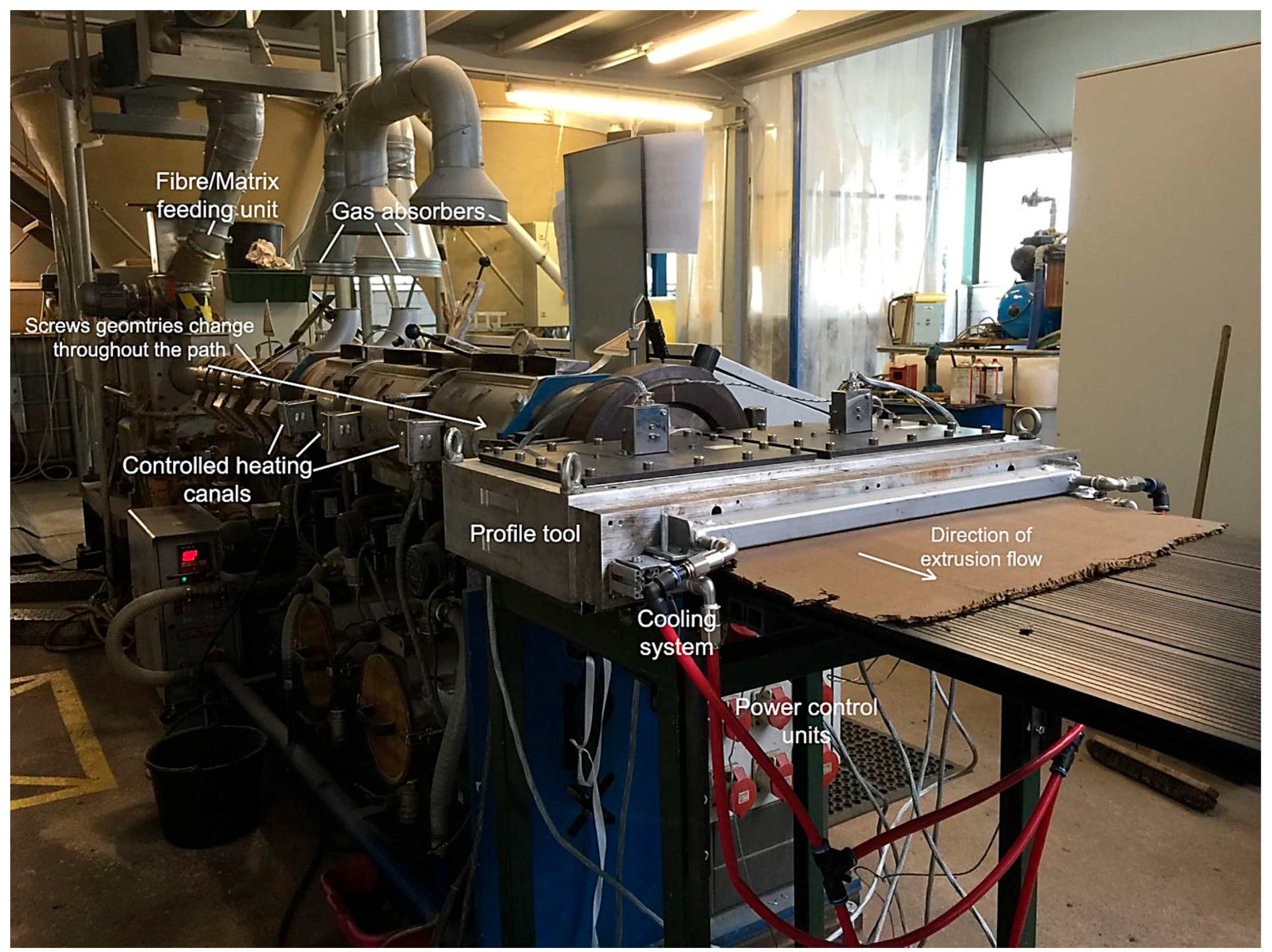


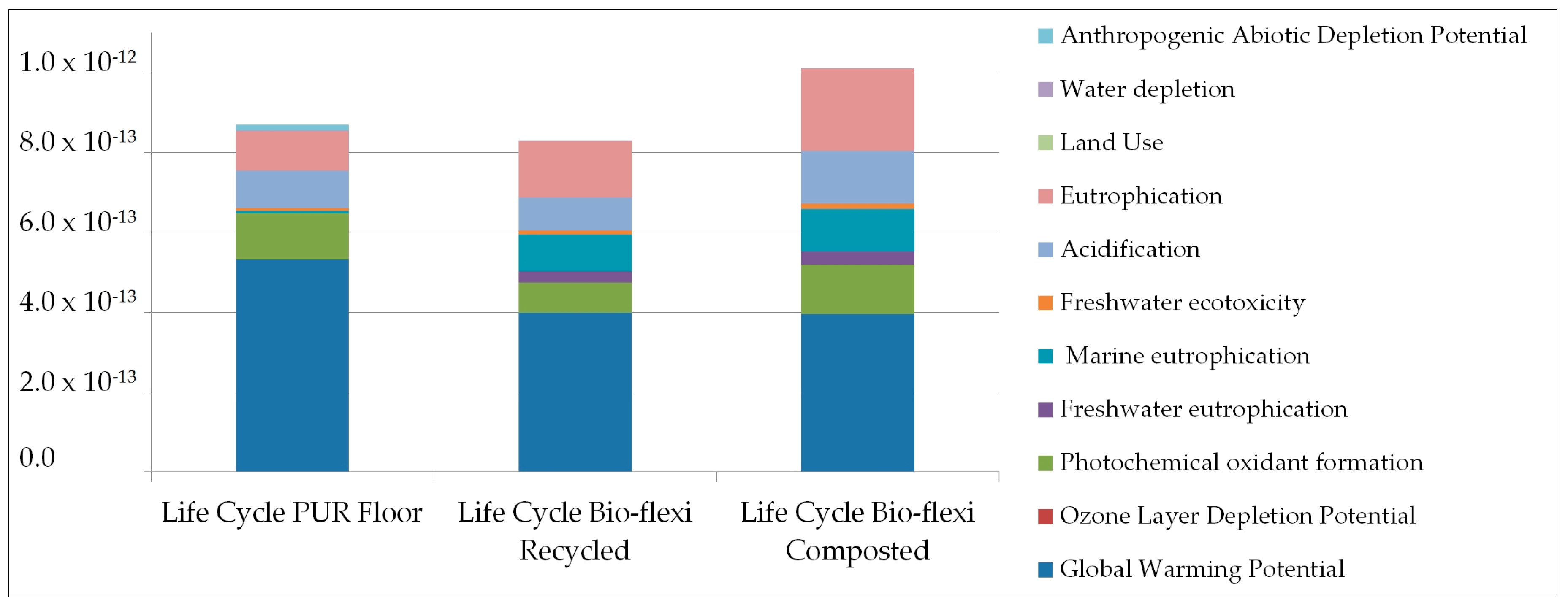


| Area of Protection | Impact Category | Abbreviation | Impact Assessment Model | Normalization |
|---|---|---|---|---|
| Global biophysical system stability | Climate change | GWP | IPCC | 4.81 × 1013 |
| Ozone depletion potential | ODP | CML | 1.34 × 108 | |
| Photochemical ozone formation | POF | ReCiPe | 2.80 × 1011 | |
| Freshwater eutrophication | EUTF | ReCiPe | 1.76 × 1010 | |
| Marine eutrophication | EUTM | ReCiPe | 1.95 × 1011 | |
| Freshwater ecotoxicity | FRTOX | UseTox | 4.46 × 1012 | |
| Acidification | AC | TRACI | 3.83 × 1011 | |
| Terrestrial eutrophication | EUTT | TRACI | 1.22 × 1012 | |
| Global resource stock | Land use | LU | LANCA | 1.00 × 1015 |
| Water depletion | WD | WSI | 4.81 × 1013 | |
| Resource depletion | AADP | AADP | 3.70 × 109 | |
| Biodiversity depletion | - | - |
| Area of Protection | Impact Category | Impact Assessment Model |
|---|---|---|
| Variable Costs | Resource costs | PIC |
| Electricity costs | PIC | |
| Other energy costs | PIC | |
| Labor costs | PIC | |
| Machine costs | FNI | |
| Disposal costs | FNI | |
| Fixed costs | Process related investments | FNI |
| Infrastructure costs | FNI |
| Area of Protection | Impact Category | Impact Assessment Model |
|---|---|---|
| Profitability | Production costs | PIC |
| Current market price | FNI | |
| Cost reduction potential | PIC + FNI | |
| Competitiveness | Current market price | FNI |
| Potential market price | FNI |
| Area of Protection | Impact Category | Impact Assessment Model | Considered Categories/Normalization Values |
|---|---|---|---|
| Human capabilities | Political freedoms | SHDB | Freedom of Association, Collective Bargaining, and Right to Strike |
| Economic facilities | SHDB | Wage Assessment; Poverty; Labor Laws | |
| Social opportunities | SHDB | Children Out of School; Child Labor; Working Time; Forced Labor | |
| Transparency guarantees | SHDB | High Conflict Zones; Legal System; Corruption | |
| Protective Security | SHDB | Access to Improved Sanitation; Access to Hospital Beds; Access to Improved Drinking Water | |
| Fairness | SHDB | Gender Equity; Migrant Workers; Indigenous Rights | |
| Human health | Human toxicity, cancer effects | USETOX (V 2.01) | 9.16 × 104 |
| Human toxicity, non-cancer effects | USETOX (V 2.01) | 1.13 × 106 | |
| Particulate matter/Respiratory inorganics | USETOX (V 2.01) | 6.86 × 1010 | |
| Ionizing radiation | Human Health effect model (V1.09) | 2.04 × 1012 |
| Area of Function | Impact Category |
|---|---|
| Load bearing | Primary support structure |
| Secondary support structure | |
| Tertiary support structure | |
| Enveloping | Vapor balance control |
| Indoor acoustics conditioning | |
| Protection against infiltration | |
| Privacy, glare and sun protection | |
| Fire protection | |
| Noise protection | |
| Illumination | |
| Natural ventilation | |
| Thermal conditioning | |
| Electricity control and supply | |
| Supply and disposal | Water supply |
| Lighting | |
| Cooling supply | |
| Heating supply |
© 2018 by the authors. Licensee MDPI, Basel, Switzerland. This article is an open access article distributed under the terms and conditions of the Creative Commons Attribution (CC BY) license (http://creativecommons.org/licenses/by/4.0/).
Share and Cite
Horn, R.; Dahy, H.; Gantner, J.; Speck, O.; Leistner, P. Bio-Inspired Sustainability Assessment for Building Product Development—Concept and Case Study. Sustainability 2018, 10, 130. https://doi.org/10.3390/su10010130
Horn R, Dahy H, Gantner J, Speck O, Leistner P. Bio-Inspired Sustainability Assessment for Building Product Development—Concept and Case Study. Sustainability. 2018; 10(1):130. https://doi.org/10.3390/su10010130
Chicago/Turabian StyleHorn, Rafael, Hanaa Dahy, Johannes Gantner, Olga Speck, and Philip Leistner. 2018. "Bio-Inspired Sustainability Assessment for Building Product Development—Concept and Case Study" Sustainability 10, no. 1: 130. https://doi.org/10.3390/su10010130







